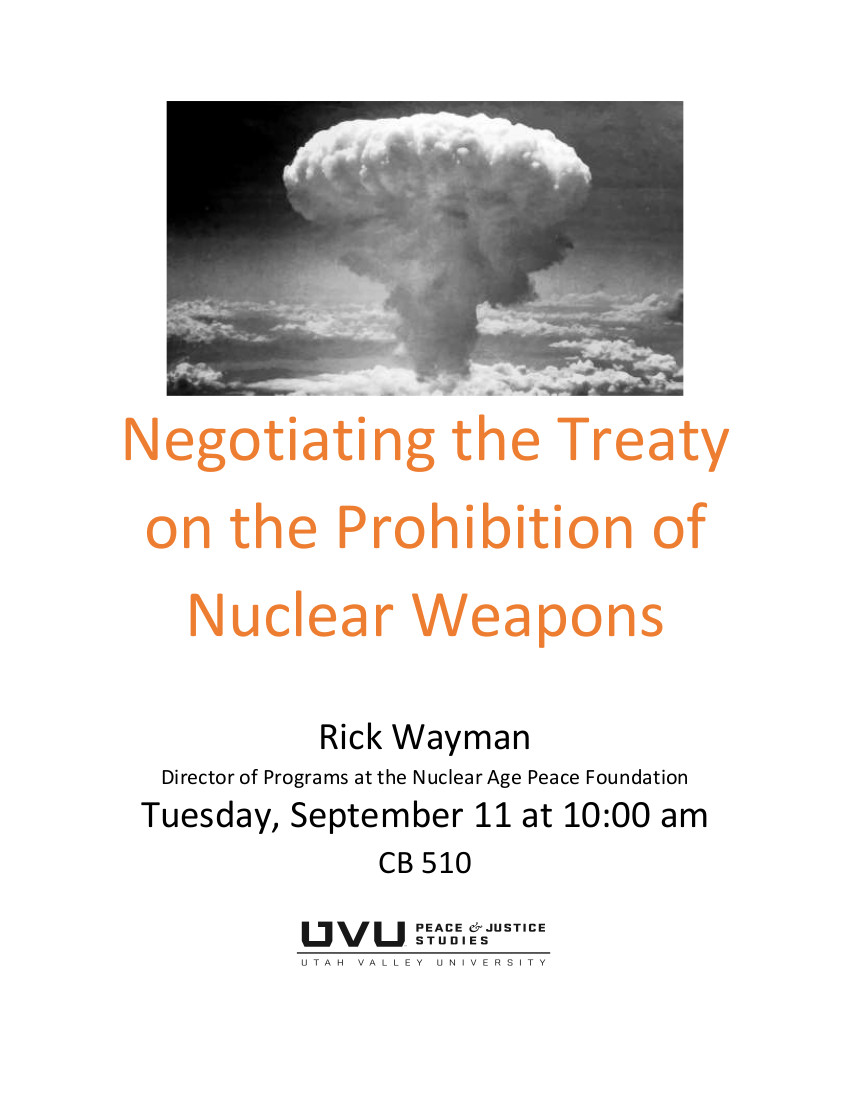
The Utah Valley University (UVU) Peace and Justice Studies program hosted Rick Wayman, Director of Programs at the Nuclear Age Peace Foundation (NAPF), on September 11, 2018. During his presentation, Mr. Wayman discussed the international Treaty on the Prohibition of Nuclear Weapons and how the treaty was devised, the prohibitions within the document and the positive obligations that accompany it, and the future of the United States’ involvement with the disarmament of nuclear weapons.
First, Mr. Wayman discussed how this treaty originated and gained traction to eventually make it to the United Nations (UN). Early on, before the treaty was established, countries including Hungary, Mexico, and Austria held conferences that highlighted some of the humanitarian issues brought on by nuclear weapons and the testing of them. These countries had survivors share their stories and express the pain and suffering that has been a result of these weapons. These smaller sessions helped to get the issue to the bigger world stage, the United Nations. In 2016, the UN held the first vote on the issue of nuclear weapon disarmament in the general session. Six months after that the treaty had its first round of debate. Shortly after this, in July of 2017, the treaty was agreed on by 122 nations of the world and became open to signatures and ratification. As of today, sixty-one countries have signed the document and fifteen have ratified it in their own countries. None of the nine countries that have nuclear capabilities have signed onto the treaty
Mr. Wayman then moved to explain the prohibitions and obligations within the treaty. The final text of the treaty contains many prohibitions on nuclear weapons; some being that nations cannot develop or research nuclear weapons, can’t transfer them to any state or group, can’t threaten to use these weapons, and cannot finance or invest in companies that produce nuclear weapons. The treaty also has a number of positive obligations placed on the countries who agree to it, a lot of which resulted from testimonies and research from non governmental organizations like NAPF. A few examples of these obligations are that nations provide victim assistance to those who have been affected by nuclear weapons in their country and they help to stabilize any part of the environment that has been impacted negatively by use of the weapons.
Finally, Mr. Wayman reviewed the United States’ stance on the treaty and how we can move forward towards progress of disarmament in our country. As the first discussions began, the US was quick to denounce the ideas behind the treaty, stating it was dangerous and could cause instability if countries gave up their nuclear arsenal. They encouraged other nations, especially those part of NATO, to not sign the treaty. This behavior was exerted by the Obama administration and the Trump administration has pushed it even harder. As the US State Department continues with this bipartisan agenda, Mr. Wayman proposed that the change is going to have to start on the state and local levels. Just recently California passed a resolution that called on the federal government to focus on the removal of nuclear weapons from the United States. This has no forceful backing, but is a start to a bigger movement that can bring around change. As more and more cities and states join in and express their concerns, it will eventually reach the point where our government has no choice but to listen to what they have to say.
This presentation was very informative on the highly important Treaty on the Prohibition of Nuclear Weapons, but also gave inspiration on how to get involved in making change in regards to nuclear weapons. This is a crucial point in our world, with nine countries possessing the ability of complete annihilation in a matter of minutes. We must urge our own government and nations around the world to commit to denuclearization, for the safety of ourselves and of future generations.
Hagen Isaacson, Member, Foreign Affairs club at Utah Valley University
***

